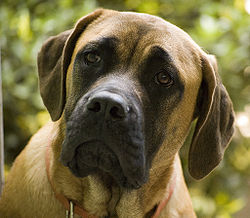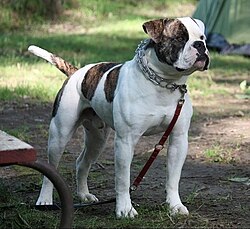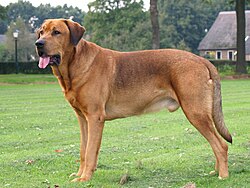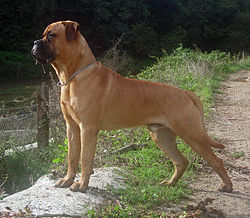Mastiff
The Mastiff, also called the English Mastiff, is a large breed of dog.[1] They have a rectangular body, thick muscles and a massive head with a wrinkled forehead.[1] They stand from 27.5 inches (70 cm) to 30 inches (76 cm) at the shoulder and typically weigh between 120 pounds (54 kg) and 230 pounds (100 kg).[2] The Mastiff is one of the largest breeds of dogs[3] who can outweigh many full-grown men.[1] They can be gentle with family members but are also excellent guard dogs.[4]
History
The early Mastiff was called a molosser or molossus.[5] Genetics and breeding dogs to get certain characteristics was unknown then. In 350 BC, Aristotle wrote that the ancestor of the Mastiff was the Molosser.[5] These were the war dogs and guard dogs kept by the Molossoi people, an ancient Greek tribe.[6] Today the two names are often used to mean the same group or family of dogs. For example, the modern St. Bernard is sometimes described as a mastiff and sometimes as a molosser type.[4]
Mastiff or Molosser breeds
While the Mastiff is a recognized breed, there are also a number of working dog varieties that are closely related to the Mastiff.[7] Many prefer to class them as molosser breeds so as not to confuse them with the Mastiff dog breed.[8] Currently there are about 14 different breeds in the molosser/mastiff family of dogs that are bred from or have a common ancestor with the Mastiff.[7] These include the:
- Argentinian Mastiff[8]
- Fila Brasileiro[8]
- Bullmastiff[8]
- Dogue de Bordeaux[8]
- German Mastiff[8]
- Cane Corso[8]
- Neapolitan Mastiff[8]
- Pyrenean Mastiff[8]
- Spanish Mastiff[8]
- Tibetan Mastiff[8]
There are also a large number of dog breeds not called molossers or mastiffs, but are related to them.[9] Some of these include the:
The list includes many more.[9]
Training and temperament
When training a Mastiff, it is important to recognize they have a certain personality type that needs additional time and patience to learn things.[10] A Mastiff is a very relaxed dog and takes his or her time in doing a task. Owners call this the "Mastiff tempo".[10] A Mastiff can't be trained the same as a Border Collie.[10] In temperament, a modern Mastiff is a patient, sweet-tempered family guardian and companion. Gentle training works best.[1] It is important to start that training early in puppyhood.[1] They are a dog of tremendous size and strength and owning a Mastiff is a large responsibility.
Mastiffs are very predictable when they are facing a threat to their family.[11] If an owner and another person act in a threatening way, the Mastiff will usually get between them to protect its owner.[11] This is hard for the other person to miss and usually results in a cooling down of a heated discussion. But, if the situation does get worse, the Mastiff will usually growl or snarl at the other person as a warning.[11]
Early socialization is important so the Mastiff knows who belongs in the house and who does not. For example, if a Mastiff puppy sees strangers coming and going all the time, they tend to see this as normal and might not recognize an intruder if they see one.[11] However, a properly trained and socialized Mastiff will usually corner a burglar or intruder.[11] Unless the intruder does something foolish, like try to hurt the dog, he or she will probably not be hurt.[11]
Mastiff Media
The Mastiff by Philip Reinagle, 1805
References
- ↑ 1.0 1.1 1.2 1.3 1.4 "Meet the Mastiff". American Kennel Club. Retrieved 25 February 2016.
- ↑ "Mastiff". VetStreet. Retrieved 25 February 2016.
- ↑ Vince Stead, New and Improved How to Raise and Train Your Mastiff Puppy Or Dog (Vince Stead, 2011), p. 7
- ↑ 4.0 4.1 Linda P. Case, The Dog: Its Behavior, Nutrition, and Health (Arnes, IA: Wiley, 2005), pp. 21–22
- ↑ 5.0 5.1 Kim Thornton, Mastiffs: Everything about Purchase, Care, Nutrition, Grooming, Behavior and Training (Hauppauge, NY: Barron's; Enfield: Publishers Group UK, 2009), pp. 5–6
- ↑ "History and Origin of the Molosser Breeds". Bulldog Information Library. Retrieved 26 February 2016.
- ↑ 7.0 7.1 "Breaking Down the Mastiff Breeds". PetHelpful. 15 October 2015. Retrieved 25 February 2016.
- ↑ 8.00 8.01 8.02 8.03 8.04 8.05 8.06 8.07 8.08 8.09 8.10 "Molosser Breeds (Molosser Dogs, Molossers, Mastiff Breeds, Molossoid Breeds, Molossian, Molossi)". Dog Breeds of the World. Retrieved 25 February 2016.
- ↑ 9.0 9.1 9.2 9.3 9.4 9.5 9.6 9.7 9.8 "Molossers: The Many Faces of Mastiffs (and more)". The Dog Guide. Archived from the original on 5 April 2016. Retrieved 25 February 2016.
- ↑ 10.0 10.1 10.2 "Training your Mastiff". Mastiffweb. Archived from the original on 9 February 2016. Retrieved 26 February 2016.
- ↑ 11.0 11.1 11.2 11.3 11.4 11.5 "Page Two of the Mastiff FAQ". Mastiff Club of America. Archived from the original on 6 March 2016. Retrieved 26 February 2016.
Other websites
- Training Molosser dogs
- Molossers: The Molosser Dog Breeds Archived 2015-10-10 at the Wayback Machine









